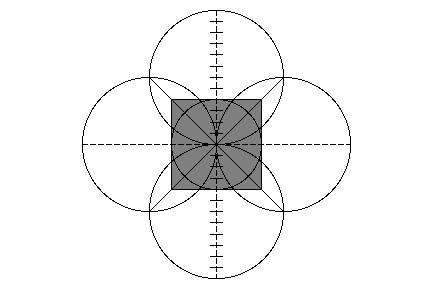|
The Mandala
Religion: Buddhism
Purpose: to
reinforce understanding and appreciation of this spiritual exercise, to
use the exercise in personal exploration Cognitive
Skills: application, synthesis Learning Styles:
active, reflective, intuitive, visual Intelligences: visual-spatial,
bodily-kinesthetic, intrapersonal, logical-mathematical
Use: in classroom,
as homework For: individuals
(pairs or small groups can "show and tell" about their work to
one another) Estimated
time: 15 - 30 minutes or more (not necessarily in one sitting when
done as homework) Materials
needed: paper or poster board, pencil, ruler, compass (or round items
to trace), colored pencils, markers, paints. Other materials may also be
used including computer graphics application. (see
detailed directions for additional ideas and materials that may be
used) Note:
can be done in front of the TV, or listening to music The
Activity:
-
Find the
center of a piece of paper: fold a piece of paper in half along the
diagonal, open it and fold it half along
the other diagonal (use a square piece of paper or, once the first
diagonal fold is made, cut off the excess from the rectangular piece
of paper)
-
Fold the paper
in half from side to side and top to bottom, using the center point
for reference (there should now be eight quadrants radiating out
from the center)
-
use a compass
or trace variously sized round lids in concentric circles from the
center point or overlapping each other, running the edge of the
circles through the center point, using the fold lines as the
diameter:

-
use a ruler to
connect points where the circles cross the fold lines
-
continue
adding circular and square geometric divisions, expanding outward

-
What is begun in
the classroom can be completed, through additional time and effort, at
home
-
Students can be
invited to write or tell about the meaning of their mandala and the
images they have chosen to include in it. This can be shared with the
teacher, in writing or orally, in pairs or small groups in the
classroom, or before the entire class.
-
Additional
directions:
Web Resources:
-
Patrick
A. George at the University of
Pennsylvania presents some basic background information on Tibentan
Mandalas and provides a diagram you can follow for designing your own
mandala
-
Jytte
Hansen offers a detailed description of the symbolism in Tibetan
mandalas
-
Michael
H. Brown introduces the mandala as a psychological tool for
exploring the self and offers some basic guidelines for creating a
mandala
-
http://www.netreach.net/~nhojem/jung.htm
presents a psychological (ala Carl Jung) perspective on the mandala
-
At
Clair
Godwin's Mandala Page you can learn all about Mandalas and how to
make them (including a computer
graphics application you can order to make your own mandalas).
Clair also provides lots of web
links to other mandala sites.
-
The
Mandala Project offers a complete lesson on mandalas. Of special
interest are the pages "What
is a Mandala?" and "Links
and Resources". "The
Mandalas" page gives you access to a gallery where you can
see many examples of mandalas created by others.
-
Here's another
online gallery of mandala images done by others
-
June
Moon provides a number of mandala and other images you can
download and color
-
Mandalas
(by Joseph Preston Baratta) contains colorful examples of all sorts of
creative (non-traditional) mandalas. Interesting to look at, to
contemplate, to be inspired by (note: to load the full size
mandala images can take some time. Be patient - the wait is worth it.)
Alternative
possibilities: may be used as a project in an art or drafting class
|